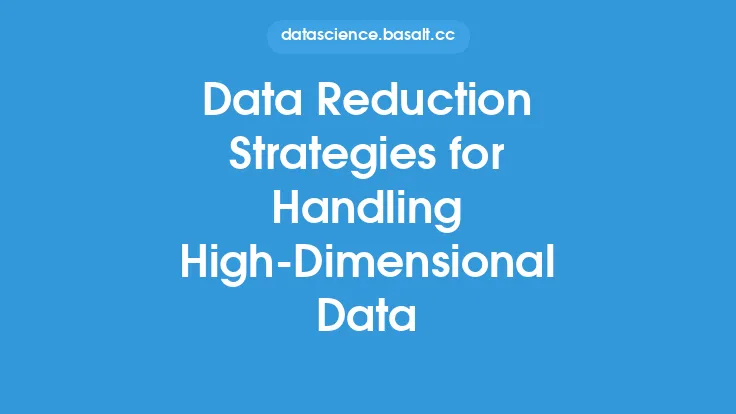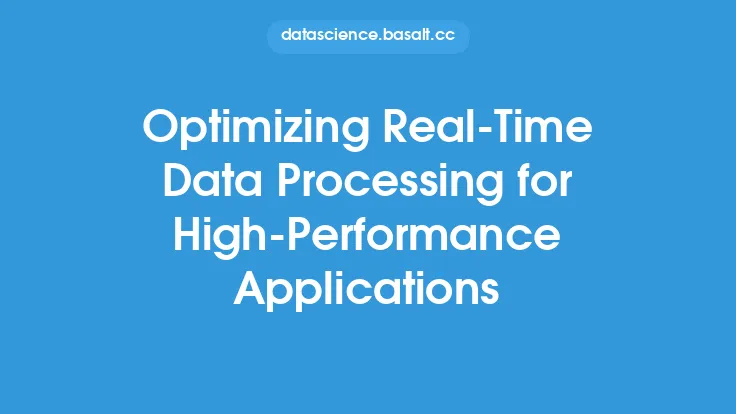Handling high-dimensional data is a common challenge in data mining, where the number of features or variables in a dataset far exceeds the number of samples or observations. This phenomenon, known as the curse of dimensionality, can lead to several problems, including overfitting, increased computational complexity, and decreased model interpretability. To mitigate these issues, data reduction strategies are employed to reduce the dimensionality of the data while preserving its underlying structure and relationships. In this article, we will delve into the various data reduction strategies for handling high-dimensional data, exploring their strengths, weaknesses, and applications.
Introduction to Data Reduction
Data reduction is a process of transforming high-dimensional data into a lower-dimensional representation, retaining the most important features and discarding the redundant or irrelevant ones. The primary goal of data reduction is to simplify the data, making it more manageable and easier to analyze, while minimizing the loss of information. Data reduction techniques can be broadly categorized into two types: feature selection and feature extraction. Feature selection involves selecting a subset of the most relevant features from the original dataset, whereas feature extraction involves transforming the original features into a new set of features that capture the underlying patterns and relationships in the data.
Feature Selection Methods
Feature selection is a widely used data reduction technique that involves selecting a subset of the most informative features from the original dataset. The key idea behind feature selection is to identify the features that are most relevant to the problem at hand and discard the rest. There are several feature selection methods, including filter methods, wrapper methods, and embedded methods. Filter methods, such as correlation analysis and mutual information, evaluate the relevance of each feature independently, whereas wrapper methods, such as recursive feature elimination, use a machine learning algorithm to evaluate the performance of different feature subsets. Embedded methods, such as L1 regularization, integrate feature selection into the training process of a machine learning model.
Feature Extraction Methods
Feature extraction is another popular data reduction technique that involves transforming the original features into a new set of features that capture the underlying patterns and relationships in the data. Principal component analysis (PCA) is a widely used feature extraction method that projects the data onto a lower-dimensional space using orthogonal transformations. PCA is particularly useful for reducing the dimensionality of high-dimensional data while retaining most of the variance. Other feature extraction methods include singular value decomposition (SVD), independent component analysis (ICA), and t-distributed Stochastic Neighbor Embedding (t-SNE).
Dimensionality Reduction Techniques
Dimensionality reduction techniques are a class of data reduction methods that aim to reduce the number of features in a dataset while preserving its underlying structure and relationships. These techniques can be broadly categorized into linear and nonlinear methods. Linear methods, such as PCA and SVD, assume a linear relationship between the features, whereas nonlinear methods, such as ICA and t-SNE, can capture complex nonlinear relationships. Other dimensionality reduction techniques include multidimensional scaling (MDS), Sammon's mapping, and autoencoders.
Clustering-Based Data Reduction
Clustering-based data reduction involves grouping similar data points into clusters and representing each cluster using a single prototype or centroid. This approach can be useful for reducing the dimensionality of high-dimensional data while preserving its underlying structure and relationships. Clustering algorithms, such as k-means and hierarchical clustering, can be used to identify clusters in the data, and the resulting prototypes can be used as a reduced representation of the data.
Information-Theoretic Data Reduction
Information-theoretic data reduction involves using information-theoretic measures, such as entropy and mutual information, to evaluate the relevance of each feature and select the most informative ones. This approach can be useful for reducing the dimensionality of high-dimensional data while preserving its underlying patterns and relationships. Information-theoretic measures can be used to evaluate the redundancy and relevance of each feature, and the resulting feature subset can be used as a reduced representation of the data.
Evaluating Data Reduction Strategies
Evaluating the effectiveness of data reduction strategies is crucial to ensure that the reduced representation of the data preserves its underlying structure and relationships. Several evaluation metrics, such as accuracy, precision, recall, and F1-score, can be used to assess the performance of a data reduction strategy. Additionally, visualization techniques, such as scatter plots and heat maps, can be used to visualize the reduced data and identify patterns and relationships that may not be apparent in the original high-dimensional data.
Conclusion
Data reduction strategies are essential for handling high-dimensional data in data mining applications. By reducing the dimensionality of the data, these strategies can simplify the data, making it more manageable and easier to analyze, while minimizing the loss of information. Feature selection, feature extraction, dimensionality reduction, clustering-based data reduction, and information-theoretic data reduction are some of the most popular data reduction strategies, each with its strengths and weaknesses. By understanding the underlying principles and techniques of these strategies, data miners can select the most appropriate approach for their specific problem and dataset, leading to improved model performance, increased interpretability, and enhanced insights into the underlying patterns and relationships in the data.





